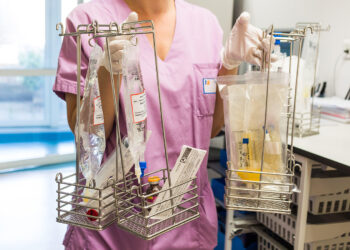[ad_1]
The anticoagulants apixaban and dabigatran do not cause more bleeding than aspirin when treating stroke or atrial fibrillation, according to an analysis of randomized clinical trials published in Annals of Internal Medicine. The anticoagulant rivaroxaban does have a higher risk of bleeding than aspirin, although the absolute risk when using any anticoagulant or aspirin is low, the analysis found.
“Lots of people take aspirin these days. They’ve had strokes; they’ve had heart attacks. A lot of them have a reason to switch” to an anticoagulant, said Michael Ke Wang, MD, an internist and health outcomes researcher at the Population Health Research Institute in Hamilton, Ontario, Canada. Reasons for switching to an anticoagulant include developing atrial fibrillation or a pulmonary embolism.

The challenge is that there is no clear way for a patient or provider to know whether an anticoagulant carries more, similar, or less bleeding risk than sticking with aspirin, Wang added. The new review offers one answer to this question.
Pooled Analysis of Randomized Trials
Wang and his colleagues synthesized findings from nine randomized controlled trials that directly compared the bleeding risks — rates of major bleeding and intracranial hemorrhage — associated with anticoagulant and aspirin.
The trials enrolled a total of 26,224 participants, with a minimum duration of treatment of 3 months.
The average age was 67 years; 58% of participants were men, and the mean follow-up time was 20 months.
“This is the best quality data we’re probably going to get when it comes to bleeding risks with these drugs,” Wang said.
The studies were published between 2011 and 2024 and compared the bleeding effects of anticoagulants and aspirin when treating chronic atrial fibrillation, subclinical atrial fibrillation, venous thromboembolism, or stroke.
The risk for major bleeding and intracranial hemorrhage did not differ between apixaban and aspirin (absolute risk difference [RD], 0.0 percentage points and 0.2 percentage points, respectively). This finding held for dabigatran vs aspirin, too, the review found. The RD for major bleeding was 0.5 percentage points [CI, 2.1-19.6 percentage points] and 0.0 points for intracranial hemorrhage [CI, 1.1-24.5 percentage points].
Five studies compared apixaban with aspirin, and two focused on dabigatran. The remaining two compared rivaroxaban and aspirin, with a greater risk for major bleeding (RD, 0.9 percentage points; CI, 0.1-3.7 percentage points) and intracranial hemorrhage (RD, 0.3 percentage points; CI, 0.1-79.7 percentage points) associated with the anticoagulant.
Given the large CIs, Wang said clinicians should exercise caution when interpreting the results — especially as the number of bleeding events was low: 566 major bleeding episodes (2.16%) and 172 (0.66%) cases of intracranial hemorrhage.
“All else being equal,” a doctor might consider prescribing apixaban or dabigatran ahead of rivaroxaban when patients are switching to an anticoagulant from aspirin, Wang said. The study does not suggest abandoning rivaroxaban altogether, Wang stressed; individual clinical factors should inform the prescribing decision.
“They took lots of different clinical indications for antithrombotic therapy. I think this is an important study because it really helps clinicians with a common conundrum” of what to do when someone eligible for an anticoagulant also has bleeding risk, said Geoffrey Barnes, MD, a cardiologist and vascular medicine specialist at the University of Michigan, in Ann Arbor.
Some clinicians prefer aspirin when balancing bleeding risk with the indication for an anticoagulant, Barnes said, reasoning that aspirin is less likely than an anticoagulant to cause bleeds. This study provides reassurance anticoagulants are just as safe for many patients, he added.
The study’s average age of 67 years was somewhat low, Barnes noted; many patients he sees are in their 70s or 80s, and bleeding risk rises with age. Also, all participants were equally eligible for aspirin or an anticoagulant; in everyday practice, some patients cannot receive an anticoagulant, or aspirin, or both. Sometimes clinicians will have reason to prescribe rivaroxaban, such as when treating chronic coronary artery disease, he said.
Barnes said rivaroxaban has not been directly tested for bleeding risk against apixaban or dabigatran; such studies are ongoing, but the data are not yet available.
“Let’s not let the bleeding risk drive things,” he said. “Let’s really focus on what is best at preventing thrombosis.”
Wang reported no financial conflicts of interest. Barnes reported consulting relationships with BMS, Pfizer, and Janssen Pharmaceuticals about anticoagulant products.
Marcus A. Banks, MA, is a journalist based near New York City who covers health news with a focus on new cancer research. His work appears in Medscape Medical News, Cancer Today, The Scientist, Gastroenterology & Endoscopy News, Slate, TCTMD, and Spectrum.
[ad_2]
Source link : https://www.medscape.com/viewarticle/anticoagulants-no-more-dangerous-than-aspirin-bleeds-annals-2025a10003e6?src=rss
Author :
Publish date : 2025-02-11 04:20:49
Copyright for syndicated content belongs to the linked Source.













